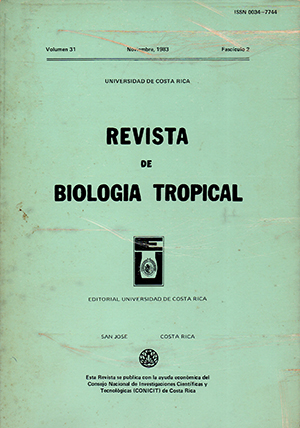Abstract
A study of mangrove oysters (Crassostrea rhizophorae) cultured in a raft system between January and June 1982 in the Vizcaya Tideland, Limón, Costa Rica showed that the rates of growth were higher for the first three months of culture, decreasing gradually in the next three months. An average length of 65.83 mm with a maximum of 85.50 mm was reached at the sixth month. Strong correlation was observed between total live weight and total length.
The minimal sexual maturity size was 13 mm with an approximate age between 15 and 22 days; spawning was not observed in individuals smaller than 21 mm.
References
Ansell, A. 1961. Reproduction, growth and mortality of Venus striatula (Da Costa) in Kames Bay,Milpot. J. Mar. Biol. Ass. U. K., 41: 191-215.
Carvajal, J. 1964. Ensayos sobre crecimiento y métodos de cultivo de ostiones comestibles Crassostrea rhizophorae en Bahía Mochima. Lagena, 2: 24-30.
Giese, A.C. 1959. Comparative physiology. Annual reproductive cycles of marine invertebrates. Annu. Rev. Physiol., 21: 547-576.
Haven, D. 1962. Seasonal Cycle of condition index oysters in the York and Rappahannock rivers. Proc. Natl. Shellfish. Assoc., 51: 42-66.
Lucas, A. 1965. Recherche sur la sexualité des mollusques bivalves. Tr. Rennes: 135 p.
Mandielli, E., & A. Acuña. 1975. The culture of the Mussel, Perna perna, and the Mangrove Oyster, Crassostrea rhizophorae, in Venezuela. MFR. Paper 1112. Marine Fisheries Review, Vol. 37 No. 1.
Mattox, W.T. 1949. Studies on the biology of the edible oyster, Ostrea rhizophorae Guilding in Puerto Rico. Ecol. Monogr., 19: 339-356.
Medcof, J.C. 1961. Oyster farming in the Maritimes. Bull. Fish Res. Board Can., 131: 157 p.
Moore, H., & N. López. 1970. A contribution to the ecology of the Lamellibranch Tellina alternata. Bull. Mar. Sci., 20: 971-979.
Moore, R, & N. López. 1972. A contribution to the ecology of the Lamellibranch Anodontia alba. Bull. Mar. Sci., 23: 381-390.
Nascimento, I.A. 1978. Reprodução da ostra de mangue, Crassostrea rhizophorae (Guilding, 1828): um subsidio ao cultivo. S. Paulo U.S.P. 200p. (Tese de Doutorado. Departamento de Biologia, Instituto de Biociencias).
Nascimento, I.A.; S.A. Pereira, & R. C. Souza. 1980. Determination of the optimum commercial size for the mangrove oyster (Crassostrea rhizophorae) in Todos os Santos Bay, Brazil. Aquaculture, 20: 1-8.
Quayle, D. B. 1981. Ostras tropicales: cultivo y métodos. Ottawa, Ont., CIID. 84 p.
Ramos, F., & O. Cendrero. 1969. Estudios ostrícolas en la Bahía de Santander. Publ. Téc. Junta Est. Pesca, Madrid. No. 8: 189-195.
Sáenz, B. 1965. El ostión antillano (Crassostrea rhizophorae) y su cultivo experimental en Cuba. Inst. Nal. Pesca Cuba (7): 1-32. (Nota de Investigaciones Pesqueras No. 6).
Sokal, R.R., & F. J. Rohlf. 1969. Biometry. W. H. Freeman, San Francisco. 776 p.
Spencer, RE., & C. J. Gough. 1978. The growth and survival of experimental batches of hatcheryreared spat of Ostrea edulis L. and Crassostrea gigas Thunberg, using different methods of tray cultivation. Aquaculture, 13: 293-312.
Tanaka, Y. 1975. Oyster culture techniques in Culture of Marine Life. Japan International Cooperation Agency, Government of Japan: 73-115.
Vélez, A.R. 1976. Crecimiento, edad y madurez sexual del ostión Crassostrea rhizophorae de Bahía Mochima. Bol. Inst. Oceanogr. Univ. Oriente, 15: 65-72.
Vélez, A.R., & J.R. Bonilla. 1972. Variación estacional del engorde del ostión Crassostrea rhizophorae, de Bahía Mochima y Laguna Grande. Bol. Inst. Oceanogr. Univ. Oriente, 11: 39-43.
Comments

This work is licensed under a Creative Commons Attribution 4.0 International License.
Copyright (c) 1983 Revista de Biología Tropical






